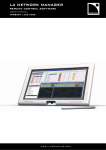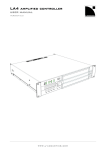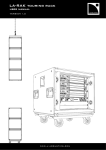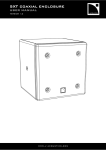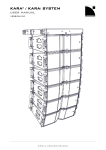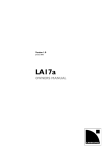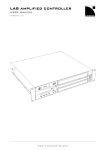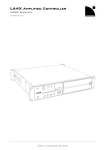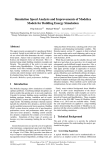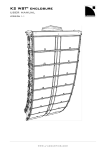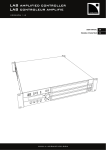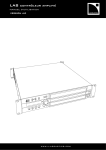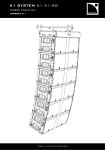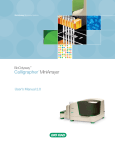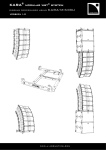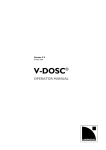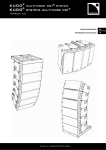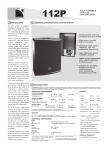Download LA Network Manager Software Manual - AV
Transcript
LA NETWORK MANAGER REMOTE CONTROL SOFTWARE USER MANUAL VERSION 1.1.0.45 www. l-a c ou sti cs. co m LA NETWORK MANAGER REMOTE CONTROL SOFTWARE User Manual VERSION 1.1.0.45 NETMAN_UM_E N_1.1.0.45 ww w .l -ac ous ti cs . co m 2/42 NETMAN_UM_E N_1.1.0.45 w w w .l-ac ous ti cs .c o m 3/42 LA NETWORK MANAGER REMOTE CONTROL SOFTWARE User Manual VERSION 1.1.0.45 1 CONTENTS 1 CONTENTS 2 2.1 2.2 2.3 INTRODUCTION 5 Welcome to L-ACOUSTICS.......................................................................................................................................... 5 Sources for LA NETWORK MANAGER software ........................................................................................................... 5 How to read this manual............................................................................................................................................... 5 3 SYSTEM CONCEPT 6 4 LA NETWORK MANAGER SOFTWARE 7 5 5.1 INSTALLATION 8 Installing the LA NETWORK MANAGER software.......................................................................................................... 8 5.1.1 Computer system requirements .................................................................................................................... 8 5.1.2 Installing the software ................................................................................................................................... 8 5.1.3 Uninstalling the software............................................................................................................................... 8 5.1.4 Software updates.......................................................................................................................................... 8 Network considerations ............................................................................................................................................... 9 5.2.1 The L-NET Network.................................................................................................................................... 9 5.2.2 Physical connections ..................................................................................................................................... 9 5.2.3 L-NET Network topologies........................................................................................................................... 9 Managing IP Addresses ............................................................................................................................................... 11 5.3.1 Introduction............................................................................................................................................... 11 5.3.2 PC IP Address setup ................................................................................................................................... 11 5.3.3 Unit IP Addresses setup .............................................................................................................................. 13 5.2 5.3 6 6.1 6.2 6.3 6.4 6.5 6.6 4 OPERATION 14 Quick start ................................................................................................................................................................ 14 6.1.1 Virtual and Physical Systems ........................................................................................................................ 14 6.1.2 Offline and Online Modes............................................................................................................................ 14 6.1.3 Launching the software ............................................................................................................................... 15 6.1.4 Software user interface ............................................................................................................................... 16 ‘‘Units Over Network’’ window.................................................................................................................................. 18 6.2.1 Overview................................................................................................................................................... 18 6.2.2 ‘‘Right Clicking’’ menu................................................................................................................................. 19 6.2.3 ‘‘PRESET’’ and ‘‘CONFIG’’ menus................................................................................................................ 22 ‘‘System/Groups’’ window .......................................................................................................................................... 23 Control window......................................................................................................................................................... 25 6.4.1 Monitoring the system ................................................................................................................................ 26 6.4.2 Offline and Online System management ....................................................................................................... 27 ‘‘Contour EQ’’ windows ............................................................................................................................................. 28 Command toolbar...................................................................................................................................................... 30 6.6.1 Overview................................................................................................................................................... 30 6.6.2 ‘‘File’’ menu ............................................................................................................................................... 30 6.6.3 ‘‘Network’’ menu ....................................................................................................................................... 31 6.6.4 ‘‘View’’ menu ............................................................................................................................................. 32 6.6.5 ‘‘Options’’ menu......................................................................................................................................... 33 6.6.6 ‘‘?’’ menu ................................................................................................................................................... 36 7 7.1 7.2 7.3 CARE AND MAINTENANCE 37 Firmware update........................................................................................................................................................ 37 Preset Library update ................................................................................................................................................. 37 Troubleshooting......................................................................................................................................................... 38 7.3.1 No Units or not all Units could be found on the Network.............................................................................. 38 7.3.2 Conflict list................................................................................................................................................. 39 8 SPECIFICATIONS 40 9 GLOSSARY 41 NETMAN_UM_E N_1.1.0.45 ww w .l -ac ous ti cs . co m 4/42 2 INTRODUCTION 2.1 Welcome to L-ACOUSTICS Thank you for purchasing an L-ACOUSTICS sound system. Each system can be remote controlled using the LACOUSTICS® LA NETWORK MANAGER Software within the L-ACOUSTICS® L-NET Network. This manual contains important information on installing the L-NET Network and operating the LA NETWORK MANAGER software. Read this manual carefully in order to become familiar with these procedures. As part of a continuous evolution of techniques and standards L-ACOUSTICS reserves the right to change the specifications of the product and the content of this manual without prior notice. Please check the L-ACOUSTICS internet website @ www.l-acoustics.com on a regular basis for latest update. If the software does not work correctly or if information is needed, please contact an approved L-ACOUSTICS distributor. In order to obtain the address of the nearest distributor go to the internet website @ www.lacoustics.com. 2.2 Sources for LA NETWORK MANAGER software The L-ACOUSTICS® LA NETWORK MANAGER Remote Control Software is a freeware. It is downloadable from the web site @ www.l-acoustics.com / technical support / LA Network Manager. 2.3 How to read this manual Many specific terms are employed throughout this manual. When needed, please refer to the Glossary part 9 for definition. Throughout this manual both following symbols are often used: The ARROW symbol notifies a procedure description. ! The IMPORTANT symbol notifies an important recommendation of use. IMPORTANT The users who are familiar with network cabling and set up procedures can directly consult the ‘‘Quick Start’’ section 6.1. NETMAN_UM_E N_1.1.0.45 w w w .l-ac ous ti cs .c o m 5/42 LA NETWORK MANAGER REMOTE CONTROL SOFTWARE User Manual VERSION 1.1.0.45 3 SYSTEM CONCEPT CONCEPT From a PC Windows®-operating system the L-ACOUSTICS® LA NETWORK MANAGER Remote Control Software provides network control and monitoring of up to 253 L-ACOUSTICS® LA4 and/or LA8 Amplified Controllers within the L-ACOUSTICS® L-NET Network. The L-ACOUSTICS® LA4 and LA8 Amplified Controllers (called ‘‘Units’’) are at the heart of the L-ACOUSTICS integrated system approach. They offer cutting edge loudspeaker Amplification, DSP, Network Control, and comprehensive System Protection in single ergonomic packages. The proprietary L-ACOUSTICS® L-NET Network allows to easily configure multiple Ethernet network topologies using CAT5e STP cables (or higher categories) and standard RJ45 connectors. The use of a universal Ethernet switcher is recommended for specific network topologies. The Figure 1 shows all L-ACOUSTICS loudspeaker systems in relation with their dedicated Units. The Units are controlled by the LA NETWORK MANAGER software within the L-NET network: KIVA 115XT HiQ KILO 12XT LA4 ARCS 8XT ETHERNET SWITCHER SB118 LA NETWORK MANAGER dV-DOSC V-DOSC LA8 KUDO SB218 dV-SUB SB28 Figure 1: L-ACOUSTICS loudspeaker systems within the L-NET Network NETMAN_UM_E N_1.1.0.45 ww w .l -ac ous ti cs . co m 6/42 4 LA NETWORK MANAGER SOFTWARE The L-ACOUSTICS® LA NETWORK MANAGER Software provides network control and monitoring of both LA4 and LA8 amplified controllers (Units) from a PC Windows®-operating system. The multiple window display (Figure 2) gives an overall visualization of the L-NET Network status, Units, Groups of Units, and all the information related to the control and monitoring of the Units. Access to all settings such as Mute, Gain, Delay, Polarity, and Preset can be done via the remote software user interface. Contour EQ settings are also available for quick and easy tonal balance of the loudspeaker systems. LA NETWORK MANAGER also features system standby and initialization control in addition to comprehensive visual monitoring of the audio signal paths and quick detection of any faults in the attached Network. LA NETWORK MANAGER features two possible workflows: the Offline and Online Modes. In the Offline Mode the user can configure a system before connecting to a Network. In the Online Mode a system can be sent to or retrieved from the synchronized Network, and the software provides real time control of each Group and Unit in the Network. Command toolbar ‘‘Units Over Network’’ window ‘‘System/Groups’’ window Control window ‘‘Contour EQ’’ window Figure 2: The LA NETWORK MANAGER user interface NETMAN_UM_E N_1.1.0.45 w w w .l-ac ous ti cs .c o m 7/42 LA NETWORK MANAGER REMOTE CONTROL SOFTWARE User Manual VERSION 1.1.0.45 5 INSTALLATION 5.1 5.1.1 Installing the LA NETWORK MANAGER software Computer system requirements Running the LA NETWORK MANAGER software requires a computer fitted with the following material: • • • • 5.1.2 Operating system: Minimum Microsoft® Windows® XP® or Mac equivalent (with a PC emulator) RAM: Minimum 512 Mo Monitor: 800 x 600, 24 bits, color Network card: 100 Mbps Ethernet card Installing the software Download and unzip the latest installation file version, say ‘‘Install LA Network Manager 1.1.0.44.zip’’ for example. Run the ‘‘Install LA Network Manager 1.1.0.44.exe’’ file. Follow the instructions given in the installation wizard (Figure 3). The application installs all necessary components needed to run LA NETWORK MANAGER software as well as a shortcut in the PC desktop to launch the software. Figure 3: The installation wizard first window 5.1.3 Uninstalling the software In the computer ‘‘Start’’ menu, select “Programs – LA Network Manager – LA Network Manager Uninstaller”. Follow the instructions given in the uninstall wizard. 5.1.4 Software updates Uninstall the old software version (see section 5.1.3). Download and install the latest software version (see section 5.1.2). NETMAN_UM_E N_1.1.0.45 ww w .l -ac ous ti cs . co m 8/42 5.2 Network considerations 5.2.1 The L-NET Network The proprietary L-NET Network uses a high speed data transfer of 100 Mbps for real-time monitoring and control of each individual Unit (LA4 or LA8 amplified controller) within a Network of up to 253 Units. Connecting the PC to a set of Units requires to physically connect the devices to each other (see sections 5.2.2 and 5.2.3) and to allocate an IP Address for each one (see section 5.3). 5.2.2 Physical connections The physical connections between the PC and the Units is achieved with CAT5e STP (or higher category) cables of maximum 100 m / 328 ft length, each one fitted with a RJ45 connector on each side. Note: STP stands for Shielded Twisted Pair. Connect the PC to a Unit by plugging one cable side into the RJ45 connector socket of the PC Ethernet card and the other cable side into the Unit’s L-NET IN connector socket (located on the rear panel: see Figure 4). Connect a first Unit to a second one by plugging one cable side in the first Unit’s L-NET OUT connector socket and the other cable side in the second Unit’s L-NET IN connector socket (see Figure 4). Figure 4: L-NET IN and OUT connector sockets located on a Unit’s rear panel 5.2.3 L-NET Network topologies Multiple L-NET Network topologies such as Daisy Chain, Star, and Hybrid are quickly and easily configurable allowing total flexibility in achieving the required system architecture. The Star and Hybrid Network topologies require the addition of a 100 Mbps universal Ethernet Switcher. ! If the Auto MDI/MDIX functionality is not available in the PC Network Card and/or the Switcher, a crossed cable between the PC and the first Unit is necessary. IMPORTANT NETMAN_UM_E N_1.1.0.45 w w w .l-ac ous ti cs .c o m 9/42 LA NETWORK MANAGER REMOTE CONTROL SOFTWARE User Manual VERSION 1.1.0.45 Daisy Chain topology Based on the series connecting scheme the Daisy Chain Network topology is the simplest way to connect the PC and the Units to each other, as it is shown in Figure 5: RJ45 connector on the 100 Mbps PC Ethernet Card LA NETWORK MANAGER L-NET RJ45 connectors Solely use CAT5e STP cables (or higher category) with a maximum length of 100 m / 328 ft. Figure 5: Daisy Chain Network topology Star topology Based on the parallel connecting scheme the Star Network topology is the most common way to connect the PC and the Units to each other. This topology requires a 100 Mbps Switcher as shown in Figure 6: RJ45 connector on the 100 Mbps PC Ethernet Card LA NETWORK MANAGER 100 Mbps Ethernet Switcher L-NET RJ45 connectors Solely use CAT5e STP cables (or higher category) with a maximum length of 100 m / 328 ft. Figure 6: Star Network topology ! The parallel connecting scheme reduces the risk of Network failure: even if the connection between the Switcher and a particular Unit fails the other Units remain connected to the Switcher. IMPORTANT NETMAN_UM_E N_1.1.0.45 ww w .l -ac ous ti cs . co m 10/42 Hybrid topology The Hybrid Network topology is a mix between the Daisy Chain and the Star topologies, e.g. a mix between the series and parallel connecting schemes, as shown in Figure 7: RJ45 connector on the 100 Mbps PC Ethernet Card LA NETWORK MANAGER 100 Mbps Ethernet Switcher L-NET RJ45 connectors Solely use CAT5e STP cables (or higher category) with a maximum length of 100 m / 328 ft. Figure 7: Hybrid Network topology Managing IP Addresses 5.3 5.3.1 Introduction It is possible to connect up to 253 Units to a master PC running LA NETWORK MANAGER within the proprietary LNET Network. In order to identify and communicate each device (PC or Unit) uses an IP Address. An IP Address is a unique address of the Internet Protocol (IP) standard. The usable L-NET IP Addresses are of the form 192.168.1. , where is taken between 1 and 254. L-ACOUSTICS recommends using the last available IP Address (192.168.1.254) for the PC Network Card. The other IP Addresses between 192.168.1.1 and 192.168.1.253 can be allocated to the Units in the L-NET Network. 5.3.2 PC IP Address setup Set the PC TCP/IP Address by following the procedure below: In the computer “Start” menu, select “Settings – Network Connections – Local Area Connection” (Figure 8). Right click on ‘‘Local Area Connection’’ and select ‘‘Properties’’ in the menu. In the ‘‘Local Area Connection Properties’’ window, double click on ‘‘Internet Protocol (TCP/IP)’’ (Figure 9). In the ’’Internet Protocol properties (TCP/IP)’’ window, select ‘‘Use the following IP address’’ and type in the IP address = 192.168.1.254 (recommended) and the Subnet mask = 255.255.255.0 (Figure 10). Click ‘‘OK’’ and close all remaining windows. Note: Fast and easy management of multiple IP Addresses (to switch between L-NET and Internet, for example) is possible using free software available on the web. NETMAN_UM_E N_1.1.0.45 w w w .l-ac ous ti cs .c o m 11/42 LA NETWORK MANAGER REMOTE CONTROL SOFTWARE User Manual VERSION 1.1.0.45 Figure 8: Selecting the ‘‘Local Area Connection’’ item Figure 9: Double clicking on the ‘‘Internet Protocol (TCP/IP)’’ item NETMAN_UM_E N_1.1.0.45 Figure 10: Filling in the IP Address and Subnet mask ww w .l -ac ous ti cs . co m 12/42 5.3.3 Unit IP Addresses setup Each Unit’s IP Address is typically of the format 192.168.1. . To modify the value of the last 3 digits (the other digits are fixed and cannot be changed) follow the procedure below: On the Unit front panel, press the Encoder Wheel. Select the NETWORK ADDRESS menu page by rotating the Encoder Wheel and press the OK key or the Encoder Wheel. Select the desired value from 1 to 253 (recommended) by rotating the Encoder Wheel. ! The selected IP Address must be different from those of the PC and other Units. IMPORTANT Press the OK key or the Encoder Wheel to validate the setting. Reboot the Unit: switch the Unit off by pressing the ‘‘On/Off switch’’, wait 30 sec for the turn-off sequence to be completed and restart the Unit. ! The new IP Address won’t be effective until the Unit has been rebooted. IMPORTANT NETMAN_UM_E N_1.1.0.45 w w w .l-ac ous ti cs .c o m 13/42 LA NETWORK MANAGER REMOTE CONTROL SOFTWARE User Manual VERSION 1.1.0.45 6 OPERATION 6.1 Quick start 6.1.1 Virtual and Physical Systems A System is a set of Units (L-ACOUSTICS® LA4 and/or LA8 amplified controllers) arranged into Groups*, and featuring: • For each Unit: the IP Address*, Unit Type*, Preset*, and Unit Parameters* (Mute, Gain, Delay, and Polarity settings for each of the 2 Input and 4 Output Channels). • For each Group: the Group Parameters* (mute, gain, delay, and contour EQ settings) uniformly allocated to all Units in the Group. Two System types exist: • The Virtual System is the System edited in the LA NETWORK MANAGER user interface when the PC is not synchronized with the L-NET Network. • The Physical System is the System composed of a set of Units physically connected to the L-NET Network (including the IP Addresses, selected Presets, Unit and Group Parameters each Unit memory contains). * Refer to the Glossary chapter 9 for a definition of the labeled terms. 6.1.2 Offline and Online Modes The System displayed in the software user interface, called the Current System, can be managed within two possible workflows: • In the Offline Mode the PC running LA NETWORK MANAGER is not synchronized with the L-NET Network. The Current System is a Virtual System. In this mode the user can create/modify the Virtual System in advance with no need to be present at the event issue. • In the Online Mode the PC running LA NETWORK MANAGER is synchronized with the L-NET Network: the data displayed on the software user interface (IP Addresses, selected Presets, Unit and Group Parameters) are those of the Units of the Physical System. They are transmitted and modified within the Full Duplex* data transfer protocol. In this mode the user can control the Physical System before and during the event performance. The Online Mode is activated when a System is sent to or retrieved from the Network (see section 6.6.3). * Refer to the Glossary chapter 9 for a definition of the labeled terms. NETMAN_UM_E N_1.1.0.45 ww w .l -ac ous ti cs . co m 14/42 6.1.3 Launching the software Double click on the LA NETWORK MANAGER shortcut located on the desktop, or select “Programs – LA Network Manager – LA Network Manager” in the computer ‘‘Start’’ menu. A new window (Figure 12) prompts the user to select between three possible ways to edit a system: Create an Offline System (Offline Mode) Select this function. Click ‘‘OK’’. The software user interface gets empty so that a new Virtual System can be built Unit by Unit. Open a System File (Offline Mode) Select this function. Click ‘‘OK’’. Browse through the new window and select the desired System File (‘‘*.system’’). The System stored in the System File is loaded in the software and becomes the Virtual System. Retrieve System from Network (Online Mode) Select this function. Select the IP Address range to be scanned through the L-NET Network by filling in the two rectangles ‘‘from 192.168.1. to ’’, where is chosen between 1 and 253. Click ‘‘OK’’. The Physical System is retrieved from the Network and becomes the Current System. The Online Mode is activated. ! The Retrieve System from Network function only works if a Network is synchronized with the PC and if the PC and units IP Addresses are correctly set (see chapter 5 for instructions, and section 7.3 for troubleshooting). IMPORTANT Figure 11: Launch window NETMAN_UM_E N_1.1.0.45 w w w .l-ac ous ti cs .c o m 15/42 LA NETWORK MANAGER REMOTE CONTROL SOFTWARE User Manual VERSION 1.1.0.45 6.1.4 Software user interface The LA NETWORK MANAGER user interface (Figure 12) features four windows and a Command toolbar (fully detailed through the sections 6.2 to 6.6) for Offline or Online overall management of the Current System. 5. Command toolbar 1. ‘‘Units Over Network’’ window 2. ‘‘System/Groups’’ window 3. Control window 4. ‘‘Contour EQ’’ window Figure 12: LA NETWORK MANAGER user interface NETMAN_UM_E N_1.1.0.45 ww w .l -ac ous ti cs . co m 16/42 The following procedure features an overview of how to create and manage a System (Virtual or Physical) using the LA NETWORK MANAGER software: 1. ‘‘Units Over Network’’ window (list of the Units) Fast create, delete, or modify the Units (IP Address, Unit Type, Preset) composing the System by left and right mouse clicking operations (see section 6.2). 2. ‘‘System/Groups’’ window (list of the Groups and attached Units) Fast form the Groups and assign Units to each one by dragging and dropping Units from the ‘‘Units Over Network’’ window (see section 6.3). 3. Control window (Unit and Group Parameter settings) Fast set the Group Parameters (apply for all Units in the selected Group) and the Unit Parameters (apply only for the selected Unit) by mouse clicking operations. The Group Parameters are the Mute, Gain, Delay, and contour EQ parameters (see step #4). The Unit Parameters are the Mute, Gain, Delay, and Polarity parameters. The Gain and Delay parameters have their Group and Unit values summed in the ‘‘Abs.’’ columns that show absolute values. In the Online Mode, this window provides real-time monitoring and control of each Group and Unit status (including audio signal path and faults) (see section 6.4). 4. ‘‘Contour EQ’’ windows (Quick tonal balance for each Group) For each group a selectable ‘‘Contour EQ’’ window allows fast intuitive 5+1 band contour EQ settings (mouse click and drag operations) (see section 6.5). 5 filters are fixed frequency filters and 1 filter is a parametric EQ filter. 5. Command Toolbar (File and Network functionalities, user options) Feature System file, Network, and software option menus (see section 6.6). NETMAN_UM_E N_1.1.0.45 w w w .l-ac ous ti cs .c o m 17/42 LA NETWORK MANAGER REMOTE CONTROL SOFTWARE User Manual VERSION 1.1.0.45 6.2 ‘‘Units Over Network’’ window 6.2.1 Overview The ‘‘Units Over Network’’ window (Figure 13) displays the list of the Units composing the Current System and allows to create/modify them. In this window features the following information: • Unit Number (No.) Counts the Units composing the System. • IP Address (Addr.) Identifies the Unit within the L-NET Network. The IP Address cell color code is: pink for the Offline Mode, green for the Online Mode, and blue for the Standby Mode (see Figure 13 and Figure 14). ! The Unit Number is not linked to the IP Address. IMPORTANT • Unit Type (Type) • Current Preset (Preset) Displays the name and memory location (from 1 to 99) of the Current Preset. • Preset Family (Family) Specifies the Preset Family to which the Current Preset belongs. Specifies whether the Unit is an LA4 or an LA8 amplified controller. Figure 13: ‘‘Units Over Network’’ window Two menus are available to manage the Units: • ‘‘Right Clicking’’ menu (see section 6.2.2): create, delete, or modify a Unit by directly right clicking on the Unit or on a blank location. • ‘‘PRESET’’ and ‘‘CONFIG’’ toolbars (see section 6.2.3): Online manage the presets in the Physical Units. NETMAN_UM_E N_1.1.0.45 ww w .l -ac ous ti cs . co m 18/42 6.2.2 ‘‘Right Clicking’’ menu Right click on a Unit: the ‘‘Right Clicking’’ menu is displayed (see Unit #1 in Figure 14). All the selectable functions are described below. Right click on a blank cell: only the ‘‘Add new Units…’’ function is displayed. Figure 14: The ‘‘Right Clicking’’ menu Figure 15: Selecting a Preset from the LA4 Library Add new Units… This function adds a new Virtual Unit. Left click on this function. The new window (Figure 15) prompts the user to select the IP Address, Unit Type, and Current Preset: Click on the ‘‘Addr.’’ cell and select an available IP Address in the displayed list. Click on the ‘‘Type’’ cell to alternatively select the ‘‘LA4’’ or ‘‘LA8’’ Unit Type. Directly load a Preset from a file by clicking on the ‘‘Load Preset from file…’’ function: browse for the desired Preset File (‘‘*.preset’’), select the user memory location (from 1 to 10) for the new Preset, and click ‘‘OK’’. or Load a Preset from the OEM Preset Library by clicking on the ‘‘Select Preset from Library’’ function: select the desired Preset among the list, select the user memory location (from 1 to 10) for the new Preset, and click ‘‘OK’’. If the list does not exist or is the wrong one the user may load the Library File prior selecting a Preset: click on the ‘‘Load Library from file…’’ function and browse for the desired Library File (‘‘*.LA4’’ or ‘‘*.LA8’’). The ‘‘*.LA4’’ and ‘‘*.LA8’’ files are downloadable from the web site @ www.lacoustics.com. An LA8 OEM Preset can not be loaded into an LA4 Unit. IMPORTANT The Preset Family directly depends on the loaded Preset. It is set automatically and thus cannot be modified by the user. ! Once the whole changes are made click ‘‘OK’’ to validate and return to the software user interface. NETMAN_UM_E N_1.1.0.45 w w w .l-ac ous ti cs .c o m 19/42 LA NETWORK MANAGER REMOTE CONTROL SOFTWARE User Manual VERSION 1.1.0.45 Delete Unit This function deletes the selected Unit. Left click on this function. Click ‘‘OK’’ in the new window: the Unit will be deleted. ! When a Physical Unit pertaining to a Group has been disconnected from the Network when using the ‘’Delete Unit’’ function the Group and Unit Parameters (see section 6.4) remain active into the Physical Unit. IMPORTANT Modify Unit… This function modifies the IP Address, Unit Type, and/or Current Preset of the selected Unit. Left click on this function. In the new window (Figure 15) the user can modify the IP Address, Unit Type, and/or Current Preset: Click on the ‘‘Addr.’’ cell and select an available IP Address in the displayed list. Trying to modify the IP Address of a Physical Unit from the LA NETWORK MANAGER user interface forces the Unit to disconnect from the Network: the Current Unit will become a Virtual Unit and the new IP Address will not be stored into the Physical Unit. Therefore, modifying the IP Address of a Physical Unit is only possible from the IMPORTANT Unit’s front panel user interface (see the ‘‘LA4’’ or ‘‘LA8’’ user manual). ! ! If a Physical Unit pertaining to a Group has been disconnected from the Network when trying to modify its IP Address in the ‘’Addr.’’ cell, the Group and Unit Parameters (see section 6.4) remain active into the Physical Unit. IMPORTANT Click on the ‘‘Type’’ cell to alternatively select the ‘‘LA4’’ or ‘‘LA8’’ Unit Type. ! Modifying the Unit Type will automatically cancel the Current Preset, thus a new Preset has to be loaded. IMPORTANT Directly load a Preset from a file by clicking on the ‘‘Load Preset from file…’’ function: browse for the desired Preset File (‘‘*.preset’’), select the user memory location (from 1 to 10) for the new Preset, and click ‘‘OK’’. or Load a Preset from the OEM Preset Library by clicking on the ‘‘Select Preset from Library’’ function: select the desired Preset among the list, select the user memory location (from 1 to 10) for the new Preset, and click ‘‘OK’’. If the list does not exist or is the wrong one, the user may load the Library File prior selecting a Preset: click on the ‘‘Load Library from file…’’ function and browse for the desired Library File (‘‘*.LA4’’ or ‘‘*.LA8’’). The ‘‘*.LA4’’ and ‘‘*.LA8’’ files are downloadable from the web site @ www.lacoustics.com. An LA8 OEM Preset can not be loaded into a LA4 Unit. IMPORTANT The Preset Family directly depends on the loaded Preset. It is set automatically and thus cannot be modified by the user. ! Note: The ‘‘Right Clicking’’ m enu allows to load presets that are stored in the PC. On the contrary, the ‘’PR ESET’’ and ‘’CONFIG’’ m enus (section 6.2.3) allows to load presets that are stored in the Physical Unit. Once the whole changes are made click ‘‘OK’’ to validate and return to the software user interface. NETMAN_UM_E N_1.1.0.45 ww w .l -ac ous ti cs . co m 20/42 Store Preset to file… This function stores the Current Preset of a selected Unit into a Preset File (‘‘*.preset’’). Click on this function. In the new window browse for the desired directory, keyboard the Preset File name, and click ‘‘OK’’. Load Preset from file… This function loads a Preset from a Preset File (‘‘*.preset’’). This Preset will become the Current Preset in the selected Unit. Select this function. In the new window browse for the desired Preset File, select the user memory location (from 1 to 10) in which the new Preset will be loaded, click ‘‘OK’’. Lock Unit Hardware Keys (Online Mode) Clicking on this function alternatively locks and unlocks the front panel commands (even the Mute function) for the selected Physical Unit. Notes: This function is useful in the Online Mode, but it can be activated in the Offline Mode and then be sent to the Physical System using the ‘‘Send System To Network’’ function (see section 6.6.3). When a Unit is locked a ‘‘key’’ is displayed in the corresponding ‘‘No.’’ cell (see Unit #2 in Figure 14). When trying to press any keys on a locked Unit front panel, the ‘‘DISPLAY LOCKED’’ message is displayed on the LCD screen and the action has not effect, even for the ‘‘Mute’’ function (see the ‘‘LA4’’ or ‘‘LA8’’ user manual). This prevents any unintentional operation during an event performance, for example. Disconnect (Online to Offline Modes) / Try to connect (Offline to Online Modes) Clicking on the ‘‘Disconnect’’ function disconnects the selected Unit from the Network. ! When a Physical Unit pertaining to a Group has been disconnected from the Network by using the ‘’Disconnect’’ function the Group and Unit Parameters (see section 6.4) remain active into the Physical Unit. IMPORTANT Clicking on the ‘‘Try to connect’’ function connects the selected Unit to the Network. ! When using the ‘‘Try to connect’’ function the Physical Unit becomes the Current Unit and the Virtual Unit Parameters are overwritten. IMPORTANT Note: The Unit mode is indicated by the color of the IP Address cell: green or blue for the Online Mode and pink for the Offline Mode (see Figure 13 and Figure 14). NETMAN_UM_E N_1.1.0.45 w w w .l-ac ous ti cs .c o m 21/42 LA NETWORK MANAGER REMOTE CONTROL SOFTWARE User Manual VERSION 1.1.0.45 6.2.3 ‘‘PRESET’’ and ‘‘CONFIG’’ menus Only available in the Online Mode the ‘‘PRESET’’ and ‘‘CONFIG’’ menus feature the same three functions: ‘‘Load’’, ‘‘Store’’, and ‘‘Name’’. They modify respectively the Current Preset, its memory location, and its name, into the selected Physical Units. They apply either for one Unit in the ‘‘PRESET’’ menu or for all the synchronized Units in the ‘‘CONFIG’’ menu. Load list Store list Name list Figure 16: ‘‘PRESET’’ and ‘‘CONFIG’’ menus Figure 17: ‘‘Load’’, ‘‘Store’’, and ‘‘Name’’ lists in the Unit#1 ‘‘PRESET’’ menu Load In the ‘‘PRESET’’ menu, the ‘‘Load’’ function applies for the selected Physical Unit and loads a Preset taken from the Preset Library stored in the Unit (see the ‘‘Load list’’ in Figure 17). The selected Preset will become the Current Preset. Click on the desired Physical Unit, click on the ‘‘Load’’ key in the ‘‘PRESET’’ menu, select the desired Preset among the edited list, and click ‘‘YES’’. In the ‘‘CONFIG’’ menu, the ‘‘Load’’ function applies for all the synchronized Physical Units simultaneously. For each Unit, the Preset is taken from one of its 10 User Memory Locations (#1 to #10 of the ‘‘Load list’’ in Figure 17). The User Memory Location number is common to all Units but the selected Preset is particular to each Unit and can be different from one to another. Click on the ‘‘Load’’ key in the ‘‘CONFIG’’ menu, select the desired User Memory Location number, click ‘‘YES’’. ! IMPORTANT In both menus the ‘‘Load’’ function only works when the selected Preset and the Current Preset are pertaining to the same Preset Family. On the contrary case (including for empty memories) a conflict list is displayed for each concerned Physical Unit (see the Troubleshooting section 7.3). Loading a new Preset the Family of which is different from the Current Preset’s one must be done by directly on the Physical Unit’s front panel. NETMAN_UM_E N_1.1.0.45 ww w .l -ac ous ti cs . co m 22/42 Store In the ‘‘PRESET’’ menu, the ‘‘Store’’ function applies for the selected Physical Unit and stores the Current Preset (including the Unit Parameters) into one of its 10 User Memory Locations (see the ‘‘Store list’’ in Figure 17). Click on the desired Physical Unit, click on the ‘‘Store’’ key of the ‘‘PRESET’’ menu, select the desired User Memory Location among the edited list, and click ‘‘YES’’. In the ‘‘CONFIG’’ menu, the ‘‘Store’’ function applies for all the synchronized Physical Units simultaneously. The User Memory Location number is common to all Units but the Current Preset is particular to each Unit and can be different from one to another. Click on the ‘‘Store’’ key of the ‘‘CONFIG’’ menu, select the desired User Memory Location, click ‘‘YES’’. Name In the ‘‘PRESET’’ menu, the ‘‘Name’’ function applies for the selected Physical Unit and renames one of its User Memory Location (from #1 to 10: see the ‘‘Name list’’ in Figure 17). Click on the desired Unit, click on the ‘‘Name’’ key of the ‘‘PRESET’’ menu, keyboard the new name in the new window, click ‘‘OK’’. In the ‘‘CONFIG’’ menu, the ‘‘Name’’ function applies for all the synchronized Physical Units simultaneously. The name and the User Memory Location number are common to all Units. Click on the ‘‘Name’’ key of the ‘‘CONFIG’’ menu, keyboard the new name, click ‘‘OK’’ and ‘‘YES’’. ! Renaming a Preset does not change the Preset Family name. A Preset can be renamed even if it is not the Current Preset. IMPORTANT 6.3 ‘‘System/Groups’’ window The ‘‘System/Groups’’ window (Figure 18) contains a list of the Groups composing the System. In this window the user can create or modify the Groups and assign Units to each one. ! Assigning a Unit to a Group is necessary to monitor and control it in the Control window (see section 6.4). In particular, this allows setting the Group Parameters (Mute, Gain, Delay, Contour EQ) that are applied to all Units of the Group. IMPORTANT Group tree icon Figure 18: The ‘‘System/Groups’’ window NETMAN_UM_E N_1.1.0.45 w w w .l-ac ous ti cs .c o m 23/42 LA NETWORK MANAGER REMOTE CONTROL SOFTWARE User Manual VERSION 1.1.0.45 Two ways to create Groups and assign Units to each one Click N times on the ‘‘Add’’ key to create N Groups. They will automatically be named ‘‘Group 1’’, ‘‘group 2’’ … ‘‘Group N’’. If wanted, rename each one by clicking on its name and keyboarding the new name. Drag and drop each Unit from the ‘‘Units Over Network’’ window to the desired Group. Drag and drop a Unit to the empty ‘‘System/Groups’’ window: a Group is automatically created and named ‘‘Group 1’’. Drag and drop the second Unit to the ‘‘Group 1’’ Group or to the empty area of the ‘‘System/Groups’’ window: in the last case the ‘‘Group 2’’ Group is automatically created. Repeat the procedure for all Units. If wanted, rename each Group by clicking on its name and keyboarding the new name. ! IMPORTANT It is not possible to create subgroups (Groups within a Group). It is possible to check if a Physical Unit is part of a Group and to identify its Group name by pressing and holding either the IN A or IN B key on the Unit front panel. The name of the Group will appear at the bottom right of the LCD (see the ‘‘LA4’’ or ‘‘LA8’’ user manual). Deleting a Unit or a Group Click on the Unit or the Group to be deleted, press the ‘‘Delete’’ key on the keyboard or in the ‘‘System/Groups’’ window, click ‘‘YES’’ in the new window. ! IMPORTANT ! IMPORTANT ! IMPORTANT In order to move a Unit from a Group to another one the user must delete the Unit from the first Group and reassign the Unit to the second Group (by dragging and dropping it from the ‘‘Units Over Network’’ window). In the Unit, the Group Parameters of the first Group will be replaced by those of the second Group. In the Online Mode, when a Unit has been deleted from a Group or if the Group containing the Unit has been deleted: • The Group Parameters are cancelled into the Physical Unit while the Unit Parameters remain active (see section 6.4). • The Outputs are muted on the Physical Unit. Consider a Physical Unit in the Standalone Mode. If some Group Parameters remain active in it, they cannot be seen and accessed via the front panel user interface, and they are not preset dependent (they will remain the same even if a new Preset is loaded). Therefore, when recuperating a Physical Unit for a Standalone application that has been previously used within a Network, L-ACOUSTICS recommends using the CLEAR GROUP PARAMETERS function in order to clear all Group Parameters (see the ‘‘LA4’’ or ‘‘LA8’’ user manual). Showing/hiding the Units Alternatively clicking on a Group tree icon displays or hides the Units pertaining to this Group. NETMAN_UM_E N_1.1.0.45 ww w .l -ac ous ti cs . co m 24/42 6.4 Control window The Control window (Figure 19) allows overall monitoring and control of the Current System through a removable tree. Meter LEDs Group name Group Parameters Unit tree icon Group tree icon Preset name IP Address Channel assignment Unit Parameters Figure 19: The Control window NETMAN_UM_E N_1.1.0.45 w w w .l-ac ous ti cs .c o m 25/42 LA NETWORK MANAGER REMOTE CONTROL SOFTWARE User Manual VERSION 1.1.0.45 6.4.1 Monitoring the system The user can display or hide information by alternatively clicking on the tree icons: by default only the maroon Group Bars are visible. Clicking on the Group tree icon adds the blue Unit Input Channel Bars, and clicking on the Unit tree icon adds the green Unit Output Channel Bars (Figure 19). Note: The Group and Unit Bar colors can be modified (see the ‘‘Settings…’’ menu in section 6.6.5). The available information is the following: • Each Group is displayed along with its Name and Group Parameters (Mute, Gain, Delay, Contour EQ). For each Group, a ‘‘Contour EQ’’ window is selectable by clicking on the ‘‘CONTR.’’ key in the Group Bar (see section 6.5). • Each Unit is displayed along with the Current Preset, IP Address, and for each Channel (2 x in, 4 x out) the Channel assignment and the Unit Parameters (Mute, Gain, Delay, Polarity). Note: The A and B Input Channels are labeled IN_A and IN_B respectively, or UNUSED if not used. The 4 Output Channels are labeled ‘‘ _ ’’ where the first 2 digits indicate the kind of transducer to be connected to the corresponding Output Channel (LF, MF, HF for Low, Mid, Hi frequency transducers respectively, SB for subwoofer, SR for reversed subwoofer in cardioid applications, PA for passive enclosure), and the last digit indicates which Input Channel the Output is driven by (A or B when the Output is driven by Input A or B respectively). • The Group and Unit Parameter values are cumulative for the Gain and Delay parameters. The cumulate values are shown in the ‘‘GAIN Abs.’’ and ‘‘DELAY Abs.’’ columns. • In the Online Mode, real time audio signal path and faults for each Channel of each Unit is given by the Meter LEDs (‘‘Load, Signal, -25, -10, -5, Clip, Limit, Fault’’) described below (please refer to the ‘‘LA4’’ or ‘‘LA8’’ user manual for additional information): LOAD The green ‘‘Load’’ LED is lit when a speaker is connected at the corresponding Unit Output Channel and when the Output power reaches at least 2 W. Example: In Figure 19 a speaker is connected to the SB118_60 Unit Output Channel #3. SIGNAL The green ‘‘Signal’’ LED is lit when a signal is detected at the corresponding Unit Channel (Input or Output). Example: In Figure 19 a signal is detected at the SB118_60 Unit Output Channel #3. dB The green “-25, -10, -5 dB” LEDs are lit when the Unit Channel voltage (Input or Output) reaches respectively 25, 10, or 5 dB below the maximum level. Example: In Figure 19 the SB118_60 Unit Output Channel #3 signal reaches 5dB below the maximum level. CLIP The red ‘‘Clip’’ LED is lit when the Channel voltage (Input or Output) reaches the maximum level. Example: In Figure 19 the SB118_60 Unit Output Channel #1 signal reaches the clip level. The ‘‘Clip’’ LED in the Group Bar is also lit. LIMIT The yellow ‘‘Limit’’ LED indicates that the L-DRIVE, Fuse Protect, or Temperature protection is active. The signal is attenuated. When the limited Channel returns to nominal state the protection automatically gets off and the Unit returns to normal operating state. Example: In Figure 19 the SB118_60 Unit Output Channel #1 signal reaches the limiter threshold. The ‘‘Limit’’ LED in the Group Bar is also lit. FAULT The red ‘‘Fault’’ LED indicates whether one or several Input or Output Channels on the Unit are no longer operational because of a DC Error, Power Failure, or DSP Error. When the faulty component returns to nominal state the protection automatically gets off and the Unit returns to normal operating state. Example: In Figure 19 the SB118_60 Unit is in faulty state (the LED located at the right of the A Input Channel LEDs is lit). The ‘‘Fault’’ LED in the Group Bar is also lit. NETMAN_UM_E N_1.1.0.45 ww w .l -ac ous ti cs . co m 26/42 6.4.2 Offline and Online System management The Control window allows the user to modify in advance (Offline) or real-time monitor (Online) the Group and Unit Parameters of the Current System. Group Parameters The Group Parameters are the Mute, Gain, Delay, and Contour EQ parameters located in the maroon Group Bar. They apply for all Units in the selected Group. Alternatively clicking on the ‘‘MUTE’’ key mutes (red color) or unmutes (grey color) all Output Channels. Example: In the Figure 19 all Output Channels of the KUDO Group are muted. Click on the ‘‘GAIN’’ cell and keyboard the Gain value: the Gain value is uniformly modified for all Output Channels. Example: In the Figure 19 all Output Channel Gain values of the SUB Group are increased by 3.5dB. Modify the Delay value in the same way as for the Gain value by clicking on the ‘‘DELAY’’ cell. Clicking on the ‘‘CONTR.’’ key edits the ‘‘Contour EQ’’ window for the selected Group. Contour EQ setting will be discussed in section 6.5. ! IMPORTANT ! IMPORTANT If a Physical Unit pertaining to a Group has been disconnected from the Network because the PC has shut down, a cable has been removed, or the ‘’New System’’ (section 6.6.2), ‘’Delete Unit’’, ‘’Modify Unit’’, or ‘’Disconnect’’ (section 6.2.2) function has been used, the Group Parameters remain active into the Physical Unit. On the contrary, when using the ‘’Delete’’ function in the ‘’System/Groups’’ window (section 6.3) the Group parameters are cancelled. Consider a Physical Unit in the Standalone Mode. If some Group Parameters remain active in it, they cannot be seen and accessed via the front panel user interface, and they are not preset dependent (they will remain the same even if a new Preset is loaded). Therefore, when recuperating a Physical Unit for a Standalone application that has been previously used within a Network, L-ACOUSTICS recommends using the CLEAR GROUP PARAMETERS function in order to clear all Group Parameters (see the ‘‘LA4’’ or ‘‘LA8’’ user manual). Unit Parameters The Unit Parameters are the Mute, Gain, Delay, and Polarity parameters located in the green and blue Unit Bars, respectively for Input and Output Channels. They only apply for the selected Channel. Alternatively clicking on the ‘‘MUTE’’ key mutes (red color) or unmutes (grey color) the selected Channel. This function is only available for the Output Channels. Example: In the Figure 19 the unit of IP Address #1 in the SUB Group has Output Channels 1 and 3 unmuted and Output Channels 2 and 4 muted. Click on the ‘‘GAIN’’ cell and keyboard the Gain value: the Gain value is modified for the selected Channel. Example: In the Figure 19 the Unit of IP Address #1 in the SUB Group has Output Channels 1 and 3 Gain value increased by 2dB. Thus, adding the Group (3.5dB) and Unit Gain (2dB) values results in a total of 5.5dB in the ‘‘GAIN Abs.’’ column. Modify the Delay value in the same way as for the Gain value by clicking on the ‘‘DELAY’’ cell. Alternatively clicking on the ‘‘POLARITY’’ key sets the polarity at 0° (+ sign, grey color) or 180° (- sign, red color). Example: In the Figure 19 the Unit of IP Address #1 in the SUB Group has Output Channels 1 and 3 set at 180°, and the Output Channels 2 and 4 set at 0°. ! If a Physical Unit pertaining to a Group has been disconnected from the Network because the PC has shut down, a cable has been removed, or the ‘’New System’’ (section 6.6.2), ‘’Delete Unit’’, ‘’Modify Unit’’, ‘’Disconnect’’ (section 6.2.2), or ‘’Delete’’ (section 6.3) function has been used, the Unit Parameters remain active into the Physical Unit. IMPORTANT NETMAN_UM_E N_1.1.0.45 w w w .l-ac ous ti cs .c o m 27/42 LA NETWORK MANAGER REMOTE CONTROL SOFTWARE User Manual VERSION 1.1.0.45 6.5 ‘‘Contour EQ’’ windows Clicking on the ‘‘CONTR.’’ key of a Group Bar in the Control window edits the corresponding ‘‘Contour EQ’’ window for this Group: the corresponding ‘‘CONTR.’’ key is colored in green, the other remain colored in gray. Example: Figure 20 shows the ‘‘Contour EQ’’ window for the KUDO Group. The ‘‘Contour EQ’’ window features a 5+1 band contour EQ setting tool applying uniformly for all Units pertaining to the selected Group. One filter is a parametric EQ filter and the other 5 filters are fixed frequency filters. Therefore, the ‘‘Contour EQ’’ tool is dedicated to loudspeaker tonal balance but not to room equalization. Those three IIR (Infinite Impulse Response) and three FIR (Finite Impulse Response) filters can be set by modifying the values in the Filter menu or by directly dragging the corresponding curves into the Curve window. Validating or resetting the values is done using the Command and Contour menus. The Curve window features the magnitude transfer function (in dB) in the frequency domain (Hz, logarithm scale) for each filter (thin curves) and for the resulting filter (thick red curve). The magnitude scale is settable using the Scaling cursors. Command menu Magnitude (dB) IIR filters Filter menu Curve window Contour menu FIR filters Scaling cursors Frequency (Hz) Figure 20: ‘‘Contour EQ’’ window Filter #1 (IIR) 60Hz fixed frequency IIR filter (LF domain): applies for subwoofers. In the Filter menu, click on the ‘‘OFF’’ key in the ‘‘BAND #1’’ column, select ‘‘ON’’: a blue cross labeled ‘‘1’’ is edited at the position ‘‘60Hz’’ into the Curve window. Set the gain to the desired value (between -15dB and +6dB) by directly dragging the cross up and down (or by clicking on the ‘‘GAIN/CR’’ key in the ‘‘BAND #1’’ column, keyboarding and validating the value). NETMAN_UM_E N_1.1.0.45 ww w .l -ac ous ti cs . co m 28/42 Filter #2 (IIR) 160Hz fixed frequency IIR filter (LF domain). In the Filter menu, click on the ‘‘OFF’’ key in the ‘‘BAND #2’’ column, select ‘‘ON’’: a blue cross labeled ‘‘2’’ is edited at the position ‘‘160Hz’’ into the Curve window. Set the gain to the desired value (between -15dB and +6dB) by directly dragging the cross up and down (or by clicking on the ‘‘GAIN/CR’’ key in the ‘‘BAND #2’’ column, keyboarding and validating the value). Filter #3 (IIR) Frequency and Q factor-settable IIR filter: magnitude response frequency settable between 100Hz and 1.5 kHz, and Q factor settable between 1 and 10 (the higher the Q factor value is, the narrower the filtering bandwidth is). In the Filter menu, click on the ‘‘OFF’’ key in the ‘‘BAND #3’’ column, select ‘‘ON’’: a blue cross labeled ‘‘3’’ is edited into the Curve window. Set the frequency and the Gain (between -15dB and +10dB) to the desired values by directly dragging the cross left and right or up and down (or by respectively clicking on the ‘‘FREQ’’ or ‘‘GAIN/CR’’ key in the ‘‘BAND #3’’ column, keyboarding and validating the value). Set the Q factor value by clicking on the ‘‘Q/ORD’’ key in the ‘‘BAND #3’’ column, keyboarding and validating the value. Filter #4 (FIR) 1.5-5 kHz fixed frequency band FIR filter (high MF domain). This filter corresponds to the blue cross located at the position ‘‘2.5 kHz’’ into the Curve window. Set the Gain to the desired value (between -15dB and +6dB) by directly dragging the cross up and down. Validate the setting by clicking on the ‘‘APPLY’’ key of the Command menu (or click on the ‘‘CANCEL’’ key to retrieve the old setting). Filter #5 (FIR) 5-12 kHz fixed frequency band FIR filter (HF domain). This filter corresponds to the blue cross located at the position ‘‘7.5 kHz’’ into the Curve window. Set the Gain to the desired value (between -15dB and +6dB) by directly dragging the cross up and down. Validate the setting by clicking on the ‘‘APPLY’’ key of the Command menu (or click on the ‘‘CANCEL’’ key to retrieve the old setting). Filter #6 (FIR) 12-30 kHz fixed frequency band FIR filter (HF domain). This filter corresponds to the blue cross located at the position ‘‘20 kHz’’ into the Curve window. Set the gain to the desired value (between -15dB and +6dB) by directly dragging the cross up and down. Validate the setting by clicking on the ‘‘APPLY’’ key of the Command menu (or click on the ‘‘CANCEL’’ key to retrieve the old setting). Contour menu Click on the ‘‘X’’ key in the Contour menu, click on the ‘‘Apply’’ key in the Command menu: all filter settings will be cancelled. Scaling cursors Click on the top or bottom Scaling Cursor to set the magnitude interval to be displayed on screen: from [-3 ; +3] to [-120 ; +120] dB. NETMAN_UM_E N_1.1.0.45 w w w .l-ac ous ti cs .c o m 29/42 LA NETWORK MANAGER REMOTE CONTROL SOFTWARE User Manual VERSION 1.1.0.45 6.6 Command toolbar 6.6.1 Overview The Command toolbar features System File management, Network connection, software option menus, and information upon the software. Figure 21: The Command toolbar 6.6.2 ‘‘File’’ menu The ‘‘File’’ menu provides System File management. Click on the ‘‘File’’ key. Figure 22: The ‘‘File’’ menu New System Edits a new System by choosing between three possible ways: creating (Offline), opening (Offline), or retrieving (Online). Click ‘‘New System’’, follow the instructions given in section 6.1.3. ! IMPORTANT This function automatically cancels all eventually prior edited Current System. If a Physical Unit pertaining to a Group has been disconnected from the Network when using the ‘’New System’’ function the Group and Unit Parameters (see section 6.4) remain active into the Physical Unit. Open System Edits a System that was previously stored in a file. Editing is possible in both Offline and Online Modes. Click ‘‘Open System’’, browse for a System File (‘‘*.system’’), click ‘‘OPEN’’. ! When a Current System is already active, opening a System File is only possible if the System stored in it is compatible (see the Glossary chapter 9) with the Current System. If both Systems are not compatible a conflict list is edited (see the Troubleshooting section 7.3). IMPORTANT NETMAN_UM_E N_1.1.0.45 ww w .l -ac ous ti cs . co m 30/42 Store System Stores the Current System to a System File. Click ‘‘Store System’’. In the new window browse for the desired directory location and keyboard the System File name, click ‘‘SAVE’’: the ‘‘name.system’’ file will be saved into the chosen directory location. Check for current System compatibility to file Checks if a System stored in a System File is compatible (see the Glossary chapter 9) or not with the Current System. Click ‘‘Check for current System compatibility to file’’. In the new window browse for a System File (‘‘*.system’’), click ‘‘OPEN’’: if both systems are compatible the ‘‘The loaded system is compatible to the current system’’ message is displayed, in the opposite case a conflict list is displayed (see the Troubleshooting section 7.3). Exit Click ‘‘Exit’’ to close the LA NETWORK MANAGER application software. ! When working in the Online Mode all synchronized Physical Units will be disconnected, but the Group and Unit parameters (see section 6.4) will remain active into each one. They can be retrieved later using the ‘‘Retrieve System From Network’’ function (see section 6.6.3). IMPORTANT ! IMPORTANT 6.6.3 Consider a Physical Unit in the Standalone Mode. If some Group Parameters remain active in it, they cannot be seen and accessed via the front panel user interface, and they are not preset dependent (they will remain the same even if a new Preset is loaded). Therefore, when recuperating a Physical Unit for a Standalone application that has been previously used within a Network, L-ACOUSTICS recommends using the CLEAR GROUP PARAMETERS function in order to clear all Group Parameters (see the ‘‘LA4’’ or ‘‘LA8’’ user manual). ‘‘Network’’ menu The ‘‘Network’’ menu provides System transfer management between the software and the Network. Click on the ‘‘Network’’ key. Figure 23: The ‘‘Network’’ menu NETMAN_UM_E N_1.1.0.45 w w w .l-ac ous ti cs .c o m 31/42 LA NETWORK MANAGER REMOTE CONTROL SOFTWARE User Manual VERSION 1.1.0.45 Send System to Network… Sends the Virtual System into the networked Physical Units. Click ‘‘Send System to Network…’’. In the new window click ‘‘YES’’: the Physical System is scanned. In the second new window click ‘‘OK’’: the Virtual System will be loaded into the connected Physical Units and the old Physical System will be overwritten, the new Physical System will become the Current System as the Online Mode will be activated. ! IMPORTANT The ‘‘Send System to Network…’’ function works only if: • A Network is synchronized with the PC and the PC and Units IP Addresses are evenly set (see part 5 for instructions, and section 7.3 for troubleshooting). • The Virtual System is compatible (see the Glossary chapter 9) with the Physical System (if both Systems are not compatible a conflict list is edited: see the Troubleshooting section 7.3). Retrieve System from Network… Retrieves the Physical System for it to become the Current System. The Online Mode is activated. Click on the ‘‘Retrieve System from Network…’’ function, click ‘‘YES’’. ! The ‘‘Retrieve System from Network…’’ function only works if a Network is synchronized with the PC and if the PC and units IP Addresses are correctly set (see chapter 5 for instructions, and section 7.3 for troubleshooting). This function automatically cancels all eventually prior edited Current System. IMPORTANT 6.6.4 ‘‘View’’ menu The ‘‘View’’ menu allows showing/hiding the Unit and Group Parameters in the Control window (see section 6.4). Click on the ‘‘View’’ key. Figure 24: The ‘‘View’’ menu Expand Tree Clicking on the ‘‘Expand Tree’’ function displays the whole available information (Groups and Units Parameters) for monitoring the System. Collapse Tree Clicking on the ‘‘Collapse Tree’’ function hides the Unit Parameters. NETMAN_UM_E N_1.1.0.45 ww w .l -ac ous ti cs . co m 32/42 6.6.5 ‘‘Options’’ menu The ‘‘Options’’ menu provides software user interface accessibility settings, maintenance operations, and Physical Unit state management. Click on the ‘‘Options’’ key. Figure 25: The ‘‘Options’’ menu Go to USER Mode / Go to ENGINEER Mode… The ENGINEER Mode is dedicated to System creation and installation before the event performance. All the functions are accessible to: • • create or modify a System setup in the ‘‘Units Over Network’’ and ‘‘System/Groups’’ windows, modify the Group and Unit Parameters in the Control window. Click ‘‘Go to ENGINEER Mode…’’. If a password has been set: keyboard the password in the new window and click ‘‘OK’’, click ‘‘OK’’ in the second new window. The USER Mode is dedicated to the Online operations before and during a live show. The accessible functions are restricted: • • • • creating a System is not possible and the access to the ‘‘Units Over Network’’ and ‘‘System/Groups’’ windows is denied, opening a System from a file is only possible if this System is compatible (see the Glossary chapter 9) with the Current System, only the authorized Group and Unit Parameters are accessible in the Control Window: accessibility is set in the ENGINEER Mode (see the ‘‘Edit Visibility’’ function), returning to the ENGINEER Mode can be locked by password (see the ‘‘Settings…’’ function). Click ‘‘Go to USER Mode’’ function. Note: The current mode is labeled on the extreme right part of the Command toolbar (see Figure 12). NETMAN_UM_E N_1.1.0.45 w w w .l-ac ous ti cs .c o m 33/42 LA NETWORK MANAGER REMOTE CONTROL SOFTWARE User Manual VERSION 1.1.0.45 Edit visibility Sets each Group and Unit Parameter accessibility (accessible or locked) in the Control window. The settings are made in the ENGINEER Mode and the restrictions will apply in the USER Mode. Activate the ENGINEER Mode (see the function above). Position the mouse cursor on ‘‘Edit Visibility’’. In the new menu click ‘‘User Level’’: the Parameter cells will be colored in green or gray in the Control Window (see Figure 26): • Green color: the parameter will be accessible in the User Mode. • Gray color: the parameter will be locked in the User Mode. Click on each Parameter cell to set the Parameter accessibility (green or gray). Position the mouse cursor on ‘‘Edit Visibility’’, click ‘‘Off’’. Activate the USER Mode (see the function above): accessible Parameters will be displayed and locked Parameters will be hidden (see Figure 27). Notes: Each accessibility setting uniformly apply for all Units of all Groups. When a parameter is locked by L-ACOUSTICS the corresponding ‘‘EXT’’ cell it is colored in gray. On the contrary case, the ‘‘EXT’’ cell it is colored in green. (a) Figure 26: The ‘‘User Level’’ Control window NETMAN_UM_E N_1.1.0.45 ww w .l -ac ous ti cs . co m (b) (c) Figure 27: Hiding the Output Channel polarity: (a) ENGINEER Mode, (b) User Level Control window, (c) USER Mode 34/42 Lock Hardware Keys Position the mouse cursor on the ‘‘Lock Hardware Keys’’ function. In the new menu click on the ‘‘Lock all Units’’ or ‘‘Unlock all Units’’ function to respectively lock or unlock the front panels of all Physical Units in the Network. Notes: This function is useful in the Online Mode but can be set in advance in the Offline Mode and then be sent to the Physical System using the “Send System To Network’’ function (see section 6.6.3). When a Unit is locked a ‘‘key’’ is displayed in the corresponding ‘‘No.’’ cell (see Unit #2 in Figure 14). If trying to press any keys on a locked Unit front panel the ‘‘DISPLAY LOCKED’’ message is displayed on the LCD screen and the action has not effect, even for the ‘‘Mute’’ function (see the ‘‘LA4’’ or ‘‘LA8’’ user manual). This feature prevents any unintentional operation during an event performance, for example. Power Standby (Online Mode) Position the mouse cursor on the ‘‘Power Standby’’ function. In the new menu click on the ‘‘All Units Power up’’ or ‘‘All Units standby’’ function to respectively put all the Physical Units in the Operating or Standby Mode. Notes: Each Unit state is indicated by the color of its IP Address cell in the ‘‘Units Over Network’’ window (see section 6.2): the green color stands for the Operating Mode, the blue color stands for the Standby Mode. When a Physical Unit is in the Standby Mode the four ‘‘Load’’ LEDs lit (on both the LCD screen and software interface) and the message ‘‘Standby Mode’’ is displayed on the LCD screen (see the ‘‘LA4’’ or ‘‘LA8’’ user manual). Update (Online Mode) Updates the Firmware or the Preset Library for the selected Physical Units (see sections 7.1 and 7.2 respectively). Settings… Sets the background color for the different branches of the tree (Groups, Units, Input and Output Channels) in the Control window (see section 6.4). Click ‘‘Settings…’’. In the ‘‘Settings’’ window (Figure 28), click on the desired background color in the ‘‘Tree Colors’’ menu. In the ‘‘Color’’ window (Figure 28), set the desired color and click ‘‘OK’’. Click ‘‘OK’’ a second time in the ‘‘Settings’’ window. Sets the Engineer Password for the ENGINEER Mode to be locked when trying to switch from USER Mode to ENGINEER Mode (the USER Mode is also activated when launching the software). In that way the user cannot modify the Current System (see the beginning of section 6.6.5). Click ‘‘Settings…’’. In the ‘‘Settings’’ window (Figure 28), enter the desired password in the ‘‘Setup Engineer Password’’ menu and click ’’Set’’. In the ‘‘Confirm with old Password!’’ window (Figure 28), enter the old password and click ‘‘OK’’. Click ‘‘OK’’ in the new window. Click ‘‘OK’’ In the ‘‘Settings’’ window. ! Do not to forget the password as it will not be removed even if uninstalling the software. IMPORTANT NETMAN_UM_E N_1.1.0.45 w w w .l-ac ous ti cs .c o m 35/42 LA NETWORK MANAGER REMOTE CONTROL SOFTWARE User Manual VERSION 1.1.0.45 Figure 28: The ‘‘Settings’’, ‘‘Color’’, and ‘‘Confirm with old Password!’’ windows 6.6.6 ‘‘?’’ menu Displays the software version and the L-ACOUSTICS internet website address for latest Software, Firmware, and Preset Library files download. Click on the ‘‘?’’ key. Click on the ‘‘About…’’ function in the new menu: a new window displays the required information. Click on this window to close it. NETMAN_UM_E N_1.1.0.45 ww w .l -ac ous ti cs . co m 36/42 7 CARE AND MAINTENANCE 7.1 Firmware update Each Physical Unit is managed by a Firmware (refer to the ‘‘LA4’’ or ‘‘LA8’’ user manual). Two Firmware Files exist and correspond to the ‘‘LA4’’ and ‘‘LA8’’ Unit Types. The user should check the L-ACOUSTICS internet website on a regular basis @ www.l-acoustics.com for the latest Firmware version for each Unit Type. 7.2 Upload the desired Firmware package and follow the instructions given in the accompanying ‘’.pdf’’ file. Preset Library update In each Physical Unit is stored a complete onboard OEM Preset Library (see the ‘‘LA4’’ or ‘‘LA8’’ user manual) to cover all principal L-ACOUSTICS loudspeaker system configurations. Two Preset Library Files exist and correspond to the LA4 (‘‘*.LA4’’) or LA8 (‘‘*.LA8’’) Unit Type. The user should check on a regular basis the L-ACOUSTICS internet website @ www.l-acoustics.com for the latest Preset Library versions. Upload the desired Preset Library package and follow the instructions given in the accompanying ‘’.pdf’’ file. NETMAN_UM_E N_1.1.0.45 w w w .l-ac ous ti cs .c o m 37/42 LA NETWORK MANAGER REMOTE CONTROL SOFTWARE User Manual VERSION 1.1.0.45 7.3 7.3.1 Troubleshooting No Units or not all Units could be found on the Network When performing the ‘‘Retrieve System From Network’’, ‘‘Send System To Network’’, or ‘‘Try To Connect’’ functions a conflict list (see section 7.3.2) can be displayed indicating that one or several expected Units cannot be found within the Network. The flowchart below assists the user for troubleshooting: No Units or not all Units could be found on the Network Devices switched on? No For each device (Unit, Switcher), check that power switch is on, AC plug is connected, AC outlet works Yes Network Topology and cabling scheme correct? No Check for correct Network Topology and cabling scheme (see section 5.2.3) Yes All CAT5e STP cables connected? No Connect each CAT5e STP cable on both sides: the orange and green LEDs must lit on each RJ45 connector socket Yes IP Address correct on each device? No Each device (PC, Units) has to be identified within the Network by its IP Address in the format 192.168.1.XXX (see section 5.3). The last 3 digits are chosen between 1 and 254 and must be different for each device. L-ACOUSTICS recommends the Address 254 for the PC and the Addresses 1 to 253 for the Units. Yes IP scanning range correct? No In the launch window (see section 6.1.3), enter IP scanning range containing all the Physical Unit IP Addresses Yes Contact local distributor for service The keys for interpretation of the flowchart are the following: Symptom NETMAN_UM_E N_1.1.0.45 Question Remedy ww w .l -ac ous ti cs . co m Comment 38/42 7.3.2 Conflict list Two Systems are compatible if they are formed of the same number of Units with each corresponding pair having the same IP Address, Unit Type, and Preset Family. If two Systems are not compatible a conflict list is displayed featuring four possible messages: Message #1: ‘‘Not found in actual system!’’ Some Units (identified by their IP Addresses) defined in the System File cannot be found in the Current System. Message #2: ‘‘Not found in file system!’’ Some Units (identified by their IP Addresses) defined in the Current System cannot be found in the File System. Message #3: ‘‘Wrong Unit Type!’’ Two Units of same IP Address are found in both Current System and System File but their Unit Types do not match (LA4 vs LA8). Message #4: ‘‘Wrong Family!’’ Two Units of same IP Address and same Unit Type are found in both Current System and System File but their Preset Families do not match. Figure 29: The four messages of the ‘‘Conflict list’’ window: #1 and #2 (top), #3 (middle), #4 (bottom) The above messages can be displayed when using the ‘‘Check for current System compatibility to file’’, ‘‘Open system’’ (section 6.6.2), or ‘‘Send System to Network’’ (section 6.6.3) function. For the last one the System File stands for the Virtual System and the Current System stands for the Physical System. Conflict messages can also be displayed when using the ‘‘Try to Connect’’, ‘‘Modify Unit’’, ‘‘Load Preset from File’’ (section 6.2.2), or ‘‘Load’’ (section 6.2.3) function. NETMAN_UM_E N_1.1.0.45 w w w .l-ac ous ti cs .c o m 39/42 LA NETWORK MANAGER REMOTE CONTROL SOFTWARE User Manual VERSION 1.1.0.45 8 SPECIFICATIONS Microsoft® Windows® XP® minimum, or Mac equivalent (with a PC emulator) RAM Minimum 512 Mo Monitor 800 x 600, 24 bits, color Network Card 100 Mbps Ethernet card Network cabling CAT5e STP (maximum 100m/328ft length) or upper category Units L-ACOUSTICS® LA4 and LA8 amplified controllers (Units of different Unit Types can be connected within the L-NET Network) Switcher (for Star or Hybrid topologies) Minimum 100 Mbps with Auto MDI/MDIX functionality Operating system NETMAN_UM_E N_1.1.0.45 ww w .l -ac ous ti cs . co m 40/42 9 GLOSSARY Compatible Systems Two Systems formed of the same number of Units with each corresponding pair featuring the same IP Address, Unit Type, and Preset Family. Current Preset Preset loaded in a Unit. Current System System displayed in the LA NETWORK MANAGER user interface. The Current System can be either a Physical System or a Virtual System. Current Unit Unit displayed in the LA NETWORK MANAGER user interface. Daisy Chain topology Series-based Network cabling scheme (see section 5.2.3). Firmware Program installed in a Physical Unit. The Firmware manages the whole Unit internal components (LCD screen display, preset flash memory, Ethernet path, DSP, Switch Mode Power Supply: refer to the ‘‘LA4’’ or ‘‘LA8’’ user manual). Firmware File Executable file named ‘‘run.exe’’ containing Physical Unit Firmware program source. Two firmware file exist for both the LA4 and LA8 Units. The user should check on a regular basis the L-ACOUSTICS internet website @ www.l-acoustics.com for the latest Firmware versions. Full Duplex Group Network protocol featuring bi-directional data transmission between the PC and the connected Units. Set of Units sharing the same Group Parameters. Group Bar Horizontal graphic bar (colored in maroon in Figure 19) located in the Control window for Group Parameter visualization and settings. Group Parameters Mute, Gain, Delay, and Contour EQ parameters applying for all Units of a selected Group. The Group Parameters can be set in the selected Group Bar (colored in maroon in Figure 19) located in the Control window. When selecting the Contour EQ parameters in the Group Bar, an additional window is displayed allowing for 5+1 band equalization settings that apply uniformly for all Units of the Group (see section 6.5). 5 filters are fixed frequency filters and 1 filter is a parametric EQ filter. Hybrid topology Network cabling scheme mixing the Daisy Chain and Star topologies (see section 5.2.3). Input Channel Connection of the Unit to the Sound Source. Two Input Channels are available on each Unit: IN A and IN B (see the ‘‘LA4’’ or ‘‘LA8’’ user manual). The Input Channels are modeled by the Input Channel Bars (colored in blue in Figure 19) in the Control window. IP Address The IP Address is a unique Internet Protocol Address to identify each device (PC or Unit) within the Network. The L-NET usable IP Addresses are of the form 192.168.1., where is taken between 1 and 254. L-NET Network Set of Physical Units synchronized with a PC running LA NETWORK MANAGER using CAT5e STP cables. Communication between the devices (PC and Units) is based on the Ethernet protocol at a speed of 100 Mbps. Three Network topologies are available: Daisy Chain, Star, and Hybrid. Network See L-NET Network. Network Card PC peripheral device for physical connection to Network. OEM Memory Location Allocated space in a Physical Unit’s flash memory to store a factory Preset (see the ‘‘LA4’’ or ‘‘LA8’’ user manual). 89 OEM Memory Locations are available in each Unit (labeled from 11 to 99). NETMAN_UM_E N_1.1.0.45 w w w .l-ac ous ti cs .c o m 41/42 LA NETWORK MANAGER REMOTE CONTROL SOFTWARE User Manual VERSION 1.1.0.45 Offline Mode PC running workflow in which the PC is not synchronized with the L-NET Network (as opposed to the Online Mode). The Current System is a Virtual System. In this mode the user can create/modify the Virtual System in advance with no need to be present at the event issue. Online Mode PC running workflow is in which the PC is synchronized with the L-NET Network (as opposed to the Offline Mode). The data displayed on the software user interface (IP Addresses, selected Presets, Unit and Group Parameters) are those of the Physical Units, and are transmitted within the Full Duplex protocol. In this mode the user can control the Physical System before and during the event performance. The Online Mode is activated when a System is sent to or retrieved from the Network (see section 6.6.3). Output Channel Connection of the Unit to the Sound System. Four Output Channels are available on each Unit: from OUT 1 to OUT 4. The Output Channels are modeled by the Output Channel Bars (colored in green in Figure 19) in the Control window. Physical System System composed of a set of Physical Units connected to the L-NET Network (including the IP Addresses, selected Presets, Unit and Group Parameters each Unit memory contains). Real Unit (as opposed to the Virtual Unit): L-ACOUSTICS® LA4 or LA8 amplified controller. Physical Unit Preset EQ settings stored in a Unit for driving a specific Sound System connected to the Unit. Preset Family Preset File Set of Presets driving the same types of Sound Systems. Computer file containing a Preset. A Preset File features the extension ‘‘*.preset’’. Preset Library Set of Presets. Preset Library File Computer file containing a Preset Library. Two Preset Library Files exist and correspond to the two Unit Types: they feature the respective extensions ‘‘*.LA4’’ and ‘‘*.LA8’’. Sound Source Device to be connected to the Input Channels of an amplified controller, feeding this last with the low voltage sound signal to be equalized and amplified. Sound System Set of loudspeaker enclosures. Standalone Mode Physical Unit operating state in which the Unit is not synchronized with Network. Standby Mode Physical Unit state in which the Unit is synchronized with Network but does not operate (as opposed to the Operating Mode). Star topology Parallel-based Network cabling scheme including a Switcher (see section 5.2.3). System Set of Units arranged into Groups, each Unit featuring its IP Address, Unit Type, Preset, Unit Parameters, and Group Parameters. System File Computer file containing a System. A System File features the extension ‘‘*.system’’. Switcher Universal Ethernet device used within a Star or Hybrid topology to connect the Units in parallel within the L-NET Network. Unit System basic component, identified by its IP Address and featuring Unit Type, Current Preset, and Unit Parameters. A Unit can be either a Virtual Unit or a Physical Unit. A Physical Unit’s flash memory can also contain a Group name and some Group Parameters (see the ‘‘LA4’’ or ‘‘LA8’’ user manual). Unit Bar Horizontal graphic bar (colored in blue or green in Figure 19) located in the Control window giving access to the Unit Parameter visualization and settings. Unit Type LA4 or LA8. Specifies the L-ACOUSTICS amplified controller model. NETMAN_UM_E N_1.1.0.45 ww w .l -ac ous ti cs . co m 42/42 Unit Parameters Mute, Gain, Delay, and Polarity parameters applying for the Input or Output Channels of a selected Unit. Some Unit Parameters can be locked by L-ACOUSTICS. The accessible Unit Parameters can be set in the selected Unit Bars (colored in blue and green in Figure 19) located in the Control window. User Memory Location Allocated space in a Physical Unit’s flash memory to store a user modified Preset (see the ‘‘LA4’’ or ‘‘LA8’’ user manual). 10 User Memory Locations are available in each Unit (labeled from 1 to 10). Virtual System with Network. Virtual Unit Network. System displayed in the LA NETWORK MANAGER user interface while the PC is not synchronized Unit displayed in the LA NETWORK MANAGER user interface when the PC is not synchronized with Operating Mode Physical Unit state in which the Unit is synchronized with Network and is operating or ready for operation (as opposed to the Standby Mode). WST® Wavefront Sculpture Technology: set of 5 technical criteria to be followed when arraying several enclosures in order to result in homogeneous modular sound field. NETMAN_UM_E N_1.1.0.45 w w w .l-ac ous ti cs .c o m 43/42 LA NETWORK MANAGER REMOTE CONTROL SOFTWARE User Manual VERSION 1.1.0.45 NETMAN_UM_E N_1.1.0.45 ww w .l -ac ous ti cs . co m 44/42 Document reference: NETMAN_UM_EN_1.1.0.45 _________________ © Copyright 2007 by L-ACOUSTICS Parc de la Fontaine de Jouvence, 91462 Marcoussis cedex, France _________________ Printed on recycled paper Distribution date: October 03, 2007 NETMAN_UM_E N_1.1.0.45 w w w .l-ac ous ti cs .c o m 45/42













































